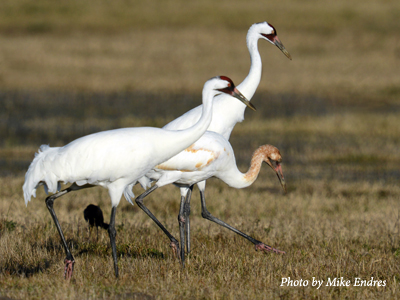
Read on for answers to your questions about the International Crane Foundation’s role in Whooping Crane recovery:
What is the International Crane Foundation’s role in Whooping Crane conservation?
Whooping Cranes are one of the rarest and most endangered bird species in North America, and face many threats, including water shortages, power line collisions, habitat destruction, predation, and shootings. To safeguard the species, Whooping Crane recovery must be approached from every angle, across all populations. For 43 years, the International Crane Foundation has worked to do just that. We are committed to the conservation of the last, naturally-occurring Whooping Crane flock that migrates between breeding grounds in Wood Buffalo National Park, Canada and wintering grounds in coastal Texas, as well as the reintroduction of additional self-sustaining populations of Whooping Cranes in Louisiana and the eastern United States according to the Whooping Crane Recovery Plan.
What is your role in the conservation of the Whooping Crane population that winters in Texas?
With programs based in Texas and along the migratory route to the Canadian breeding grounds, the International Crane Foundation is deeply invested in securing the last remaining wild flock of Whooping Cranes, which is recovering from fewer than 20 individuals in the 1940s to more than 300 today. Our goals include identifying protecting habitat along the central Texas coast wintering grounds that will accommodate both a growing crane population and habitat changes due to sea-level rise (current critical habitat areas will be lost due to rising sea levels). We are also working to ensure fresh water flows in Texas’ Guadalupe/San Antonio River basins to sustain healthy bays and estuaries for Whooping Cranes, other wildlife, and the coastal economy. In addition, our staff is engaged in monitoring the Whooping Crane population and closely working with local communities to increase awareness about the importance of Whooping Cranes – not only to the environment, but also to local economies and quality of life.
What is your responsibility to the reintroduction of Whooping Cranes in the eastern United States?
Because the small natural-occurring population that winters in Texas will remain vulnerable to disease, natural disasters, and human encroachment for decades to come, additional populations are being reintroduced as an “insurance policy” for Whooping Crane survival. We are a founding member of the Whooping Crane Eastern Partnership, a group of non-profit organizations and government agencies formed to establish a migratory population east of the Mississippi River. Our role in the partnership includes strategic genetic breeding, egg production, raising chicks for release, monitoring released birds, habitat research, and outreach and education.
How are you supporting the reintroduction of Whooping Cranes in Louisiana?
A non-migratory Whooping Crane population is being reintroduced in Louisiana, to which we will contribute chicks raised by costumed staff – the costumes hide the human form and keep the chicks from bonding with people – for release this year along with our partner, Patuxent Wildlife Research Center. Earlier this spring, two Whooping Crane chicks hatched in Louisiana – the first chicks there in 75 years! – a huge victory in the effort to reintroduce Endangered Whooping Cranes to their historic range in southern Louisiana. We extend heartfelt congratulations to the Louisiana Department of Wildlife and Fisheries and all our partners and supporters for this success.
How will the recent changes in the Whooping Crane rearing and release methods affect your breeding program this year?
The changes in the Whooping Crane Eastern Partnership’s rearing and reintroduction methods seek to limit the amount of time chicks spend with costumed staff, while emphasizing as much interaction as possible with adult Whooping Cranes (click here to learn more about these changes). To achieve this goal, our highest priority for the eastern migratory population will be to focus on parent-rearing – several of our adult Whooping Crane pairs will hatch and raise chicks without the use of costumed staff. Prior to their first fall migration, the chicks will be released in Wisconsin near wild Whooping Crane pairs. Our goal is for the adult pairs to “adopt” the young birds and teach the chicks their migratory route. This release method has been tested in Wisconsin with Whooping Crane chicks raised by our partners at the Patuxent Wildlife Research Center with promising results.
Will the changes in the Whooping Crane rearing and release methods allow you to continue to contribute to the Louisiana reintroduction?
Our staff will continue to costume-rear Whooping Crane chicks at our chick rearing facility for the Louisiana reintroduction. Due to the still small, but growing, size of the Louisiana flock – currently at 42 birds –the protocols for raising chicks for reintroduction in this population have not yet changed.
We have now reached an exciting new frontier in ensuring that wild Whooping Cranes thrive in North America, and the International Crane Foundation – with your support – will continue to play a leading role. Your investment in this work has never been more important. It is only with your help that we will be able to write the next chapter for Whooping Cranes. Click here to donate.
